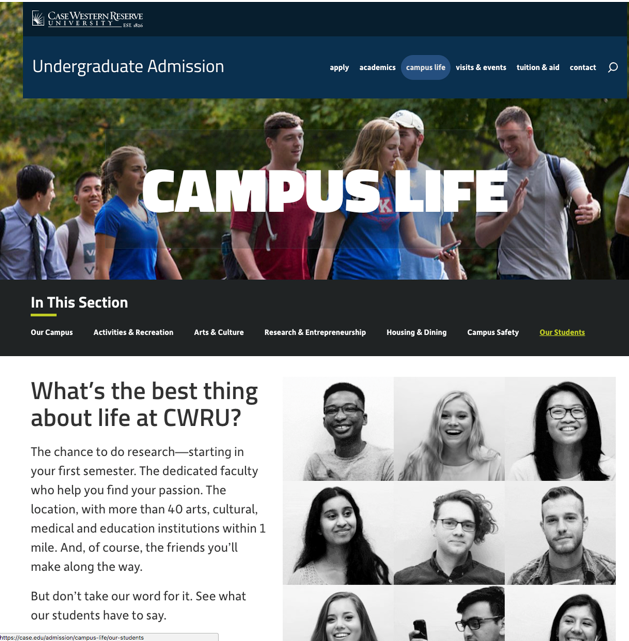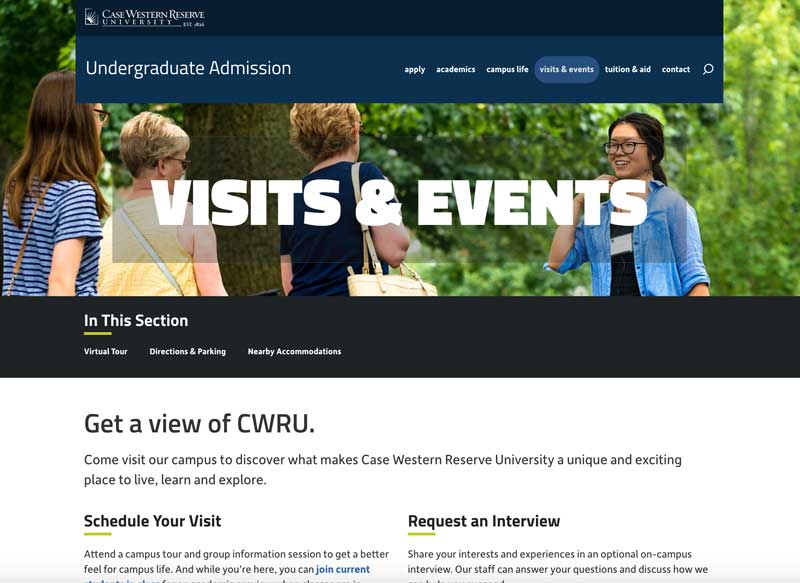
How a small group of students can have a big impact on your website
We all know that before you start a website redesign, you need to talk to your audience.
You need to determine what they must find, what questions they want answered, what pain points they face, what they’re dying to see more (or less) of… and the list goes on.
But when your core audience is 16- and 17-year-olds from around the world who already are overwhelmed by the college-search process and their own academic and extracurricular schedules, how feasible is it to get them in a room for a focus group?
How likely is it that they’ll respond to an email survey or tree test? (And don’t forget: You’re already inundating them with emails about why they should attend your school—so hitting them up with a survey on top of those messages probably won’t garner you bonus points in their books, and certainly will bring ill will from your admissions team.)
This is the conundrum we faced at Case Western Reserve University, as our team undertook a redesign of our Undergraduate Admission website.
Still, we knew we needed to tap into that psyche to better connect with this audience. We needed to watch how they used our site; to see where they looked for information; to analyze what words, phrases or photos made them smile (or scowl).
In short: We needed tour guides.
These highly motivated, energetic and engaged students were critical to our website redesign process, and they can be for you, too. Here’s why—and how.
Proximity to Prospective Students
I mean this in two ways.
For starters, they are near the age—often just a year or two older—of traditional prospective undergraduate students. Not long ago, these wise 18- and 19-year-olds were nervous, excited 16- and 17-year-olds attending college fairs, reading (or trashing) hundreds of emails and brochures, and perusing your and your peer schools’ websites.
They remember what it’s like to be in that sometimes-frenzied, often-overwhelming and always-thrilling college-search process. They know what questions they had—and what they were afraid to ask.
They also literally are near prospects —walking and talking with visiting students daily. They may be the first line of personal contact a potential student and their family members have with your university, so they’ve heard nearly all of the questions prospective students have—and they also know what hotspots or fun facts you should highlight on the website to grab their often-fleeting attention.
How did we use tour guides in our higher ed web redesign process?
Let’s start at the beginning.
Research & Testing
 We included tour guides (among many, many others) in our focus groups and interviews, asking them not only about their own college-search and decision-making processes but also what they hear on the front lines as campus tour guides.
We included tour guides (among many, many others) in our focus groups and interviews, asking them not only about their own college-search and decision-making processes but also what they hear on the front lines as campus tour guides.
Next, we had some of the tour guides (plus other non-guides) test our live website for its strengths and shortcomings. Then we had another group test our new architecture and other elements to make sure they could easily navigate our site and find exactly what prospective students need.
Because of their proximity—in both location and age—these tour guides know how prospective students think and act. They likely are as close as you can get to actually interviewing and testing with high schoolers (though, if at all possible, you should do that too).
Photos & Video Shoots
Next, we needed new photos and video.
And, of course, we scheduled shoots in two of the most inopportune times for students: summer break and the week of Thanksgiving. Convenient, right?
But tour guides have been there for us—literally. They are on campus in the summer, unlike many undergraduates. And because they worked for our client, the Office of Undergraduate Admission, it was easy to snag them for a 20-minute photo shoot when we needed them.
Faces of the University
Featuring tour guides on your site is helpful well beyond their availability, though.
Tour guides are relatable—not just because they are actual students and not stock-photo models, but because your prospective students may have met them already, or may be about to cross their paths.
So, let’s say a prospective student goes on a tour, falls in love with your campus (fingers crossed!) and then visits your website to gather some more information before they apply. They come across a photo of their guide who helped shape their wonderful visit—and voila!
 You’ve made that connection and reminded them why they want to take that next step to apply. (Though, admittedly, you do run the risk that a guide might have a bad day. Make sure you have plenty of non-tour guides in your mix too.)
You’ve made that connection and reminded them why they want to take that next step to apply. (Though, admittedly, you do run the risk that a guide might have a bad day. Make sure you have plenty of non-tour guides in your mix too.)
The way we included these students on our website is, hands-down, my favorite feature on any website we’ve created so far. Beyond just the standard campus beauty photos, we captured their personalities in headshots, quick Q&As and, best of all, fun and authentic GIFs (check them out at case.edu/admission/campus-life). And being on these shoots connected me with the true personalities of our students, which undoubtedly shaped the tone with which we wrote the copy for the site.
So when you undertake a website redesign, remember: If you can’t talk to your audience directly, talk to the people who talk to your people. Showcase their memorable (and relatable) faces and personalities.
And above all else: Create a website they’ll love. If you do, they’ll talk about it—and drive traffic for you.
Meet the Author: Emily Mayock
Emily Mayock is the Assistant Vice President of Online and Internal Communications at Case Western Reserve University and a graduate of the Higher Ed Experts’ professional certificate programs in Social Media and Web Writing for Higher Ed and Social Media Marketing for Higher Ed.
Tags: Higher Ed Marketing Memos, Higher Ed News